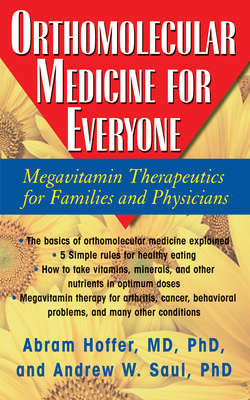Читать книгу Orthomolecular Medicine for Everyone - Abram Hoffer M.D. Ph.D. - Страница 38
A CLOSER LOOK AT VITAMIN SUPPLEMENTS
ОглавлениеVitamins are organic molecules normally found in living tissue in very small amounts. They are essential for most of the metabolic reactions in the body, wherein they act as catalysts or as portions of catalysts called enzymes. As catalysts, they are used over and over. They do not contribute calories, as do carbohydrates and fats, nor do they contribute to the structural integrity of tissues.
By definition, vitamins cannot be made in the body, but this definition was made before enough was known about vitamins. Some of the vitamins, by this definition, are not vitamins: vitamin D3 is made in the body by the effect of ultraviolet light on the skin; vitamin C is a vitamin only for humans and a few other species and is made in the bodies of most animals in large quantities; vitamin B3 (niacin and niacinamide) is made in the body from the amino acid tryptophan. But these three substances have been classed as vitamins for so long that it is highly unlikely they will be classified as anything else.
Nutritionists have been long concerned about the optimum amount of vitamins the body needs. When vitamins were first identified, it was recognized that very small amounts were needed to prevent the typical terminal or deficiency disease. The vitamins were discovered and identified by measuring the effect of various food fractions on animals, plants, or bacteria that were fed a diet lacking that vitamin. To detect thiamine (vitamin B1), food extracts were fed to pigeons made to suffer beriberi by a specially prepared, thiamine-free diet. Very little thiamine is needed to prevent and cure beriberi; this is also true of other deficiency diseases, such as scurvy and pellagra. Scientists assumed that no additional vitamins were needed if these deficiency diseases were absent. If a patient did not have pellagra, he or she needed no additional vitamin B3. Later on, nutritionists realized that patients had symptoms of deficiency that were not severe enough to be diagnosed as the fully developed disease. Patients were diagnosed with subclinical pellagra—they were not near death, as are pellagrins, but they were not well either, and they did become normal when given additional quantities of vitamins.
Official recommended dietary allowances (RDA or DRI) reflect the view that very minute quantities of vitamins are required, but they also recognize that requirements vary with age, physiological state, and degrees of stress. Nevertheless, the maximum doses recommended in the RDA/DRI tables are little higher than the minimal doses required to prevent classical deficiency diseases. The tables also reflect the quantity of vitamins obtainable from food. They do exclude the use of vitamins for most people to supplement their diet. Supporters of the recommended allowances believe that a balanced and varied diet will be adequate for the vast majority of people. Even if this were true, it still ignores a huge number of people who are not well and who are patients at one time or another. There are no recommended dose tables of vitamins for patients.
Many patients have recovered when treated with large doses of vitamins, doses that are 100 to 1,000 times those recommended to prevent the terminal deficiency diseases. A few patients require 1 mg per day of vitamin B12, which is 1,000 times the average daily dose. To lower cholesterol and triglyceride levels, patients require 3,000 mg (3 g) of niacin per day, which is several hundred times the pellagra-preventive dose. Some schizophrenic patients have needed 30 g (30,000 mg) per day or more. The term megavitamin therapy was developed to describe these larger doses, but the term is not particularly useful because it confuses many into thinking there is something called a “megavitamin.” The term megadose vitamin therapy is better, as it focuses on the use of large quantities.
Physicians using these large doses recognize that individuals have different vitamin requirements and that the range of variation is much greater than had been suspected several decades ago. We now recognize that the range of vitamin needs for optimum health varies from those quantities present in good, whole food, to doses up to a thousand times greater. The main problem for an orthomolecular physician is to determine what that optimum level is.
